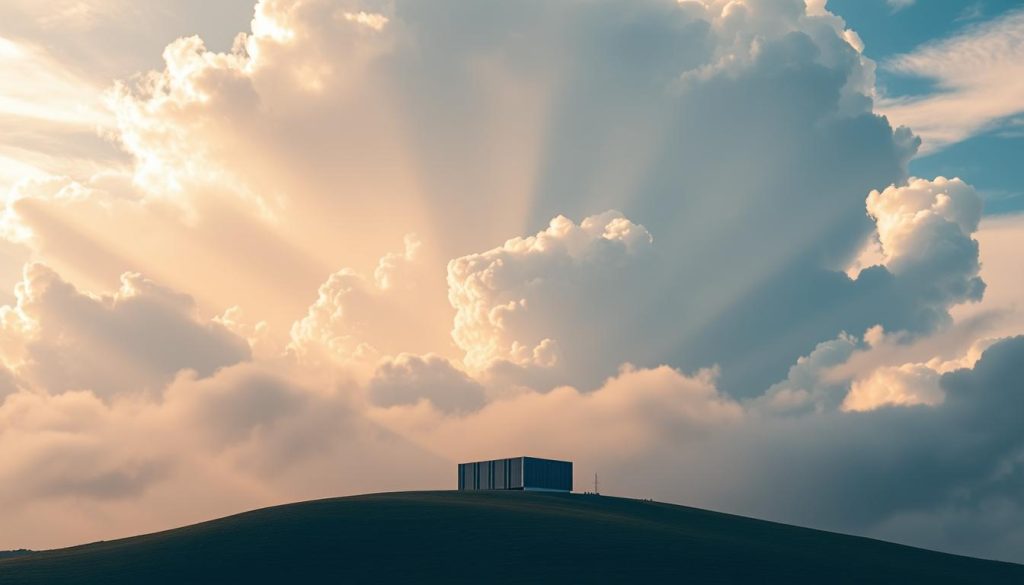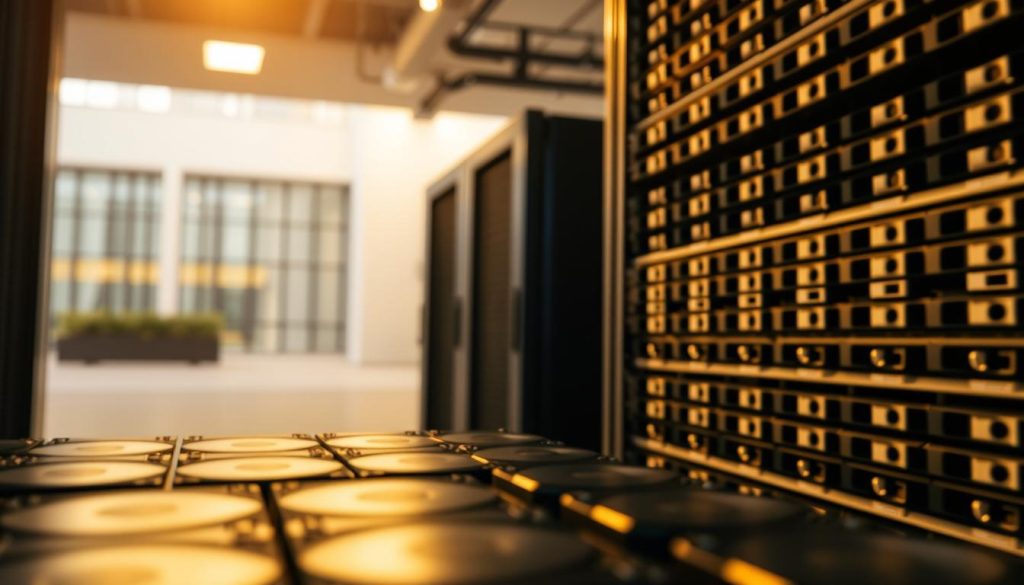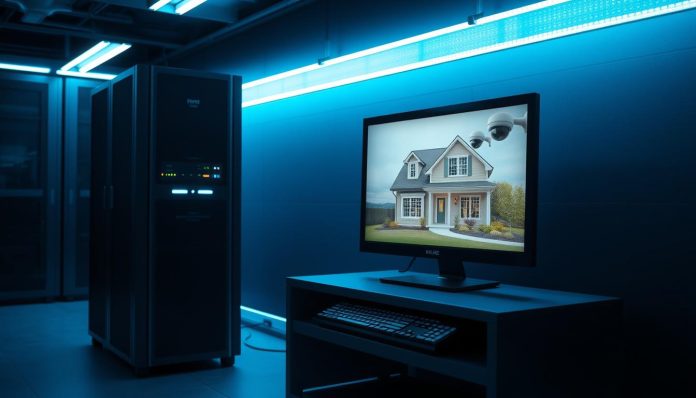This buyer’s guide helps U.S. homeowners choose an offsite plan that protects recorded video from theft, drive failure, or disaster while keeping access simple.
Cloud-based storage is rising fast: by 2025, half of global data may live in the cloud. Local-only setups hit limits like finite capacity and physical risk. A hybrid model gives 24/7 on-site recording with event clips sent to remote storage for redundancy.
This guide shows how modern PoE NVR/DVR systems can record continuously and upload motion or AI-triggered clips to services such as Google Drive or Dropbox. You’ll learn how to evaluate providers, size storage and bandwidth, and set retention that fits risk and budget.
Key Takeaways
- Hybrid approaches blend quick local access with cloud redundancy.
- Cloud vendors offer encryption, MFA, and compliance features.
- Plan uploads and retention to avoid bandwidth overload.
- Use substream or event-only uploads to save space and cost.
- Compare providers on cost, retention, and compliance for your needs.
Why offsite backups matter for home video surveillance today
Offsite copies matter because a stolen recorder or failed drive can wipe out weeks of crucial video evidence. On-site-only storage faces real limits: finite storage space, device theft, and hardware failure all threaten recorded data.
In busy locations a single 1TB DVR can fill fast, forcing repeated drive upgrades and higher lifetime costs. Theft or damage of recorders can erase the only copy of an incident, leaving users with no evidence for police or insurers.
Cloud platforms now offer elastic storage and configurable retention windows. That flexibility lets homeowners match space and retention to risk and budget without constant hardware swaps.
Many companies in the industry push hybrid setups: NVR/DVR units keep 24/7 local video, while event clips copy automatically to remote storage for redundancy and quick access.
All drives fail eventually. Offsite redundancy reduces the risk of irreversible loss and shortens the time between incident and retrieval, helping responders and law enforcement act faster.
- Example: a break-in during a power outage or recorder theft can erase on-site evidence, but a remote copy preserves the timeline.
What “secure offsite backup” really means for your surveillance system
A secure offsite backup combines encryption, access controls, and redundant copies stored away from your property so a single device loss does not erase critical evidence.

Common threats: theft, drive failure, and disasters
Recorders and drives can be stolen during a break-in. Local devices also suffer unpredictable failure and can corrupt stored data.
Natural disasters or fire may physically destroy equipment and all on-site copies at the same time.
Security goals: encryption, redundancy, and retention you control
Encryption in transit and at rest prevents intercepted streams or stolen credentials from exposing sensitive video or footage.
Multi-factor authentication and strict user policies reduce unauthorized access and tampering.
- Redundancy: keep at least two independent copies — local 24/7 recording plus remote event archives — so one loss doesn’t mean total loss.
- Retention: pick windows (30–365 days) per camera or event type to balance cost, privacy, and investigative needs.
- Prioritization: set rules so entryway cameras and alarm events keep longer retention than low-risk areas.
Many systems historically run with 0% redundancy and accept that most footage is never reviewed. That low-probability strategy can fail catastrophically when a rare incident occurs and drive recovery is costly or impossible.
Choosing your storage model: local, cloud, or hybrid for home needs
Deciding where your recorded video lives affects costs, access speed, and long-term resilience. Pick a model that fits your cameras, bandwidth, and how much risk you can accept.
Local storage on NVR/DVR and drives: strengths, limits, and risk exposure
Local storage gives direct control and works without internet. Access is fast for review and exports.
Its limits include finite capacity and maintenance of hardware and drives. If a recorder is stolen or a drive fails, data loss is likely.
Cloud storage: scalability, remote access, and automated backups
Cloud storage scales with demand and enables remote review from phones or a browser. Providers handle backups, encryption, and MFA for account safety.
Downsides are upload bandwidth needs and ongoing subscription costs that add up over time.
Hybrid storage: keep recent footage on-site, archive events to the cloud
Hybrid models combine 24/7 local recording with event-based uploads to remote storage. This balances fast local access and offsite redundancy.
Example policy: keep the last 14 days locally and archive high-signal clips to the cloud for 90 days. That reduces cloud storage costs while preserving critical clips.
Which model fits your cameras, budget, and risk tolerance
- Consider camera count, resolution, and internet upload when sizing any storage system.
- Check that your NVR/DVR and software support cloud linking and overwrite rules.
- Homes with rare incidents often favor event-only uploads; higher-risk areas may keep longer cloud retention.
How cloud backups of surveillance footage work behind the scenes
A typical clip travels from the camera through local hardware and across your internet link before resting on cloud servers. This flow involves capture, compression, and a controlled upload that matches your bandwidth and retention settings.

From camera to cloud: recording, compression, and upload workflow
IP cameras capture raw frames and use codecs to compress video into manageable files. Those files are queued by a recorder or device and sent to remote servers over the network.
Professional systems often keep full-resolution recordings locally while sending event clips via a substream (commonly 720p) to reduce upload load.
Retention periods: weeks, months, and years based on requirements
Homeowners commonly pick weeks for basic coverage, months for seasonal review, or up to a year for higher-risk contexts. Providers like Coram offer retention from 30 to 365 days with encryption and flexible plans.
Sending footage directly to the cloud vs. via NVR/DVR
Some cameras push footage directly to cloud storage for simplicity. Many setups route events through an NVR/DVR for smarter detection and local resilience before uploads.
- Files are usually MP4, organized by recorder, date, and channel for easy search and playback.
- Example: use Google Drive’s free 15GB for a few days of event clips, then upgrade to 100–200GB as requirements and camera count grow.
- Security must-haves include MFA and encryption in transit and at rest.
Limits and risks to plan for before you move footage to the cloud
Cloud storage can protect critical clips, but upload capacity and account security are the two biggest constraints. Plan both before you enable any automatic transfers.

Internet upload speeds and bandwidth planning
Every camera that uploads consumes upstream bandwidth. A single camera often needs roughly 2 Mbps during an event, so multiply that by the number of simultaneous events.
If you expect three cameras to upload at once, provision about 6–8 Mbps of upload to avoid saturation and retransmits.
Substream uploads and event-based policies
Use a substream (commonly 720p) for cloud clips to cut upload load and storage costs. Most homes keep 24/7 recordings on local NVRs while sending only event clips to remote servers.
Account security and practical risks
Make sure MFA/2FA is enabled for any cloud account (Google Drive requires it). Use strong passwords and least‑privilege roles to limit access.
Expect power or ISP outages. Proper setups record locally during outages and resume uploads when service returns.
Practical tuning and privacy note
Consider fiber or a higher-tier cable plan if you have many cameras. As an example, throttle non-critical channels overnight and prioritize entryway cameras.
Direct-to-cloud methods can raise privacy and data‑handling questions; review provider policies before enabling footage directly cloud workflows.
Key buying factors for a secure, scalable offsite backup solution
Estimate future storage needs by modeling cameras, resolution, and expected event frequency. This shows how volumes and storage scale as you add cameras or raise retention periods.

Scalability
Check how the storage system expands when you add channels, increase resolution, or extend retention. Look for elastic plans that grow without long migrations.
Cost model
Decode pricing beyond the headline: monthly tiers, transfer fees, and retention charges can add up. Confirm whether automatic overwrite or tiered archives are included.
Integration
Confirm compatibility with your NVR/DVR and confirm MP4 export and organized folder mapping. Authentication, APIs, and SSO cut integration time.
Retention, compliance, and management
Tie retention periods to real needs: many homes choose 30–90 months (30–90 days), while regulated sites keep 6–12 months or years.
- Security: MFA/SSO, granular user roles, and audit logs.
- Management: alerts for failed uploads, overwrite rules, and easy recovery workflows.
- Servers: ask about regions, uptime, and maintenance windows for latency and data residency.
Best Way to Back Up Home Surveillance Footage Securely Offsite: practical setup
Start with a reliable wired camera network and a recorder that can manage local storage and cloud transfers. This reduces packet loss and keeps event uploads predictable.
Required hardware and network
You’ll need PoE cameras, a PoE NVR/DVR, a router with enough LAN ports, and a stable internet connection for outbound uploads.
Tip: Use wired PoE for power and data on one cable to simplify installation and improve reliability.
Account preparation
Create or sign in to a cloud account such as Google Drive or Dropbox. Enable MFA before linking the recorder and confirm plan limits match your expected event volume.
Event detection and upload rules
Start with motion detection, then enable AI human/vehicle filters to cut false alarms. Name cloud folders by channel and set MP4 as the file format for easy playback.
- Enable overwrite mode so the oldest clips delete automatically when space fills.
- Use a 720p substream for event uploads while keeping full-resolution recordings locally.
- Baseline: keep two weeks locally and 30–90 days of cloud events for entry points.
Test it: Trigger a few events and verify clips appear with timestamps, channel names, and correct folders. This confirms your data and video are flowing as expected.
Step-by-step: backing up camera recordings to the cloud with a DVR/NVR
Linking your recorder and a cloud account is straightforward when you follow a fixed checklist. Start by securing the account and then enable per‑channel uploads so only important events consume space.
Create or verify your cloud account and enable MFA
Sign in to Google Drive and enable 2‑Step Verification. Make sure you store recovery codes where admins can reach them.
Connect the recorder and enable motion/AI per camera
Plug the NVR/DVR into your router, log into the local UI, and enable motion or SMD (human/vehicle) per channel.
Customize cloud settings and activate linking
Set uploads to MP4, name folders by recorder and channel, and choose Cloud Overwrite (1, 3, 7, 14, 30, 90 days). Click Activate Cloud, enter the device code at google.com/device, and grant permissions.
- Optionally enable AI rules (perimeter or line‑crossing) to cut irrelevant clips.
- Validate by triggering events and finding MP4 files in Drive by device, date, and channel.
- Document the setup and keep admin credentials with MFA backup codes.
“Confirm the cloud status shows Activated and available capacity before relying on remote archives.”
Sizing and budgeting: storage space, bandwidth, and retention planning
Work backward from desired retention to calculate storage and network needs. Decide how long you need clips available, then size storage and upload capacity around that period.
Bandwidth math:
Mbps per camera and total upload capacity
A single active event stream typically needs about 2 Mbps. Multiply that by the number of cameras likely to trigger at once.
For example, three simultaneous events ≈ 6 Mbps. Allow headroom (20–30%) for retransmits and other home traffic.
Storage math:
Files, event frequency, and retention periods
Estimate clips per camera per day, then multiply by average clip size and retention days. That yields total storage required.
Use substream 720p for event uploads to keep clip sizes lower while preserving useful detail.
Picking the right tier: free vs. paid plans and months-long retention
Free tiers (Google Drive 15GB) help pilot setups but fill fast. Paid tiers such as 100GB ($1.99/mo) or 200GB ($2.99/mo) suit 30–90 day retention for modest systems.
Longer retention (months or years) raises monthly costs and favors stricter filters like AI human/vehicle rules to reduce clip volumes.
| Example setup | Daily clips per camera | Avg clip size | Retention | Estimated storage |
|---|---|---|---|---|
| 2-camera low motion | 5 | 2 MB | 30 days | 600 MB |
| 8-camera moderate motion | 20 | 3 MB | 30 days | 14.4 GB |
| 8-camera moderate motion | 20 | 3 MB | 90 days | 43.2 GB |
| 8-camera high motion | 60 | 3 MB | 90 days | 129.6 GB |
“Tune detection zones and schedules to cut false positives and control storage use.”
Practical tips: review event volumes monthly and adjust clip length, sensitivity, or retention. Periodic checks keep costs aligned with actual needs and data patterns.
Recommended solutions and providers for secure offsite surveillance backups
Not all providers handle AI search, mobile review, and tiered storage the same way. Choose a solution that fits your camera count, budget, and retention needs. Test with your expected event volumes before committing.
Coram
Hybrid-cloud video management with AI-powered search speeds investigations and finds clips by object, time, or event. Coram offers custom retention from 30–365 days and automated storage management that balances local disk and cloud storage to control costs.
Security: strong encryption, MFA/SSO, and integrations with IP cameras simplify device linking. Files are organized by device/date/channel and exported as MP4 for easy review.
Reolink
Budget-friendly option for many users. Reolink focuses on motion-triggered cloud recording, simple mobile apps, and quick setup.
Tradeoffs include fewer enterprise analytics, but it provides a straightforward, low-cost path to store data offsite and keep essential clips accessible without complex management.
Avigilon
Enterprise-grade analytics and hybrid storage for larger properties and institutions. Avigilon pairs advanced video analytics with integrations (access control, VMS) and self-learning cameras.
Expect higher initial costs and planning time, but strong management tools and scalability for complex requirements and high volumes.
- Common must-haves: MFA/SSO, encryption, MP4 files, and clear device-level folder structures on servers.
- Shortlist providers by AI search depth, mobile ease, and whether they support footage directly cloud from devices or via an NVR.
- Always run a short pilot with your cameras and expected event rates to confirm costs and storage behavior over time.
| Provider | Strengths | Typical users | Retention options |
|---|---|---|---|
| Coram | Hybrid architecture, AI search, automated storage | Property owners needing fast investigations | 30–365 days |
| Reolink | Low cost, motion cloud clips, easy mobile access | Small residences, budget setups | Short-term/event-based |
| Avigilon | Advanced analytics, integrations, scalable management | Large estates, institutions | Custom enterprise tiers |
Conclusion
With today’s upload speeds, households can keep short event clips in the cloud while storing full video locally.
Use a 24/7 NVR/DVR for local recording paired with event-based cloud uploads to add resilience without high ongoing costs. This hybrid setup gives scalable storage, encrypted offsite copies, and remote review from phones or browsers.
Plan bandwidth and retention up front. Size your internet and set clip rules so entry cameras get longer retention while low-risk zones keep shorter windows.
Start small: pilot a camera or two, verify clip rates and quality, then raise tiers or tweak sensitivity to match real data.
Review settings each season, keep firmware and apps current, and enforce MFA and clear overwrite policies. That helps your data last for months or years without surprises.
Action: shortlist Coram, Reolink, and Avigilon and deploy a hybrid solution that fits your budget and protects critical footage over time.

